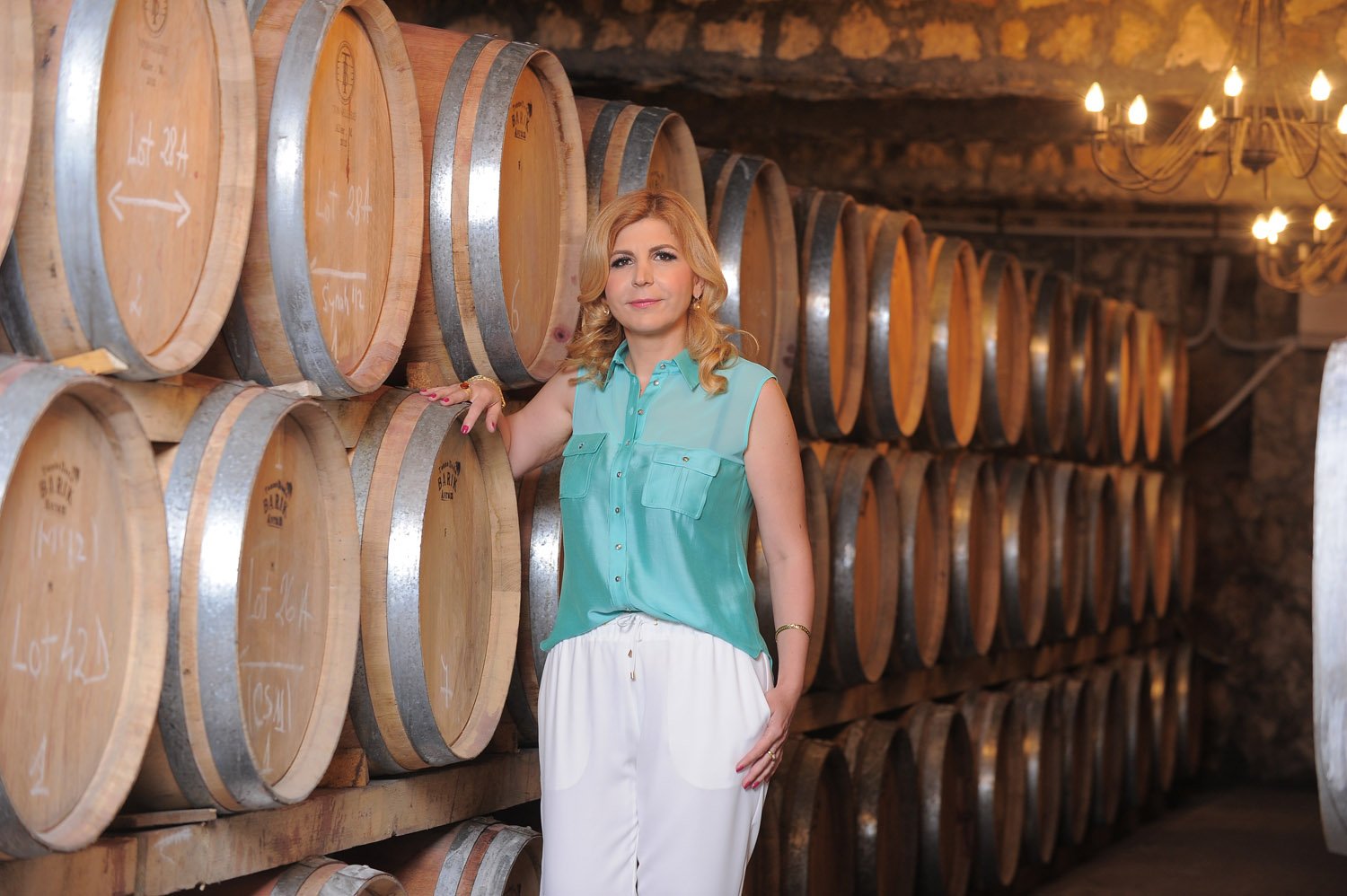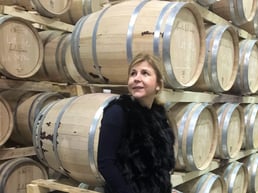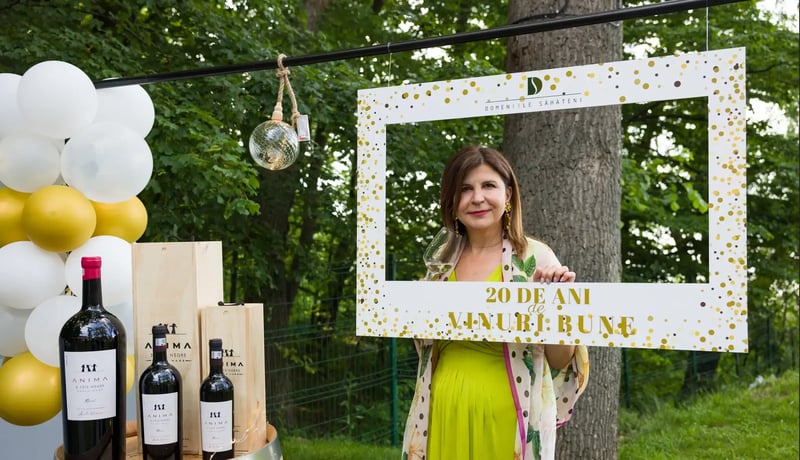During my visit to Domeniile Săhăteni, I got the chance to spend some time with Aurelia Vișinescu, the most famous female wine-maker in Romania and one of the country’s best wine makers.My first impression of Aurelia was of a modesty and warmth. Later I could see her interact with her team, who she treats like family. I have rarely seen this in the corporate world and I have my deepest admiration for her leadership style. This shows that with love, respect and care, you can do something great, where people enjoy work because they like what they are doing and not because they need the paycheck at the end of the month.
Few know that Aurelia was the first to vinify Fetească Neagră, a Romanian popular indigenous grape, as a dry wine, aged in oak barrels. Previously, it was made as a sweet or demi-sweet wine. She is very modest about this too :’I did nothing special, just tried a new approach.’ Now everybody makes it dry.

How did Aurelia Vișinescu’s passion for wine start?
AV: I grew up in the countryside. I always loved flowers and nature. That’s why I specialized in horticulture during my university. I thought I will work with flowers, but my life took me on the wine road. It was love at first sight. After university, in 1993 I started working for VINEXPORT, a private Romania company, who was exporting wine abroad. Working for them, I got the chance to go abroad and attend wine fairs. I also did an internship in Capetown, South Africa for three months and two in Australia, in 1997 and 1999, I think. My heart lies with the Old World, which is valuable, full of knowledge, even if I am schooled in the New World.
My name became known when I made a new Fetească Neagră at Halewood (down the road from Domeniile Săhăteni), dry and aged in barrique. Nobody did that before, but the market liked it and everybody did the same thing afterwards. I did nothing special I just tried something new.
How did you decide to go on your own?
AV: we incorporated the firm in 2003. I have this cousin with a lot of entrepreneurial spirit and this cousin has a husband from Canada. I took him to a lot of wine tastings with me and he started to ask me:’aren’t we going to make a winery of our own? How much does it cost?’. I responded: ‘ a lot, you don’t have this money!’. But my they insisted and we decided to do the project. At Halewood I did a project to apply for EU SAPARD financing and I did the same for our winery. We bought the actual location, which was a state farm. The cellar was a winery before the communist collectivization. We restored its initial destination. So, this is how we started, with a lot of loans, stressed about budget and having enough money to pay my suppliers.
It was very hard and we had some difficult years. The first harvest I did it with my family, in 2006. Nobody knew how to use all the equipment we bought. I didn’t know either how to use a press. At Halewood, as production director I had an office job. I was going in inspection and I was tasting the wines. So, Aurelia, with books in her hands was pressing buttons trying to control the machines. We did not have our grapes either. We were buying from local grape growers. With my brother, we were staying every night until midnight to sort the grapes based on quality and weigh them, making sure we did not buy stones. I lost 10 kg.
When did you launch the first wines on the market?
AV: We launched in 2008, with a brand named Divin. It had some weird colored labels with blue and green. It did not go well. So, we decided to make some changes and relaunch We spent a year an a half on re-branding and in 2010, the peak of financial crisis in Romania, we launched the Aurelia Vișinescu brand. I was a new player in a market where wine producers had to pay listing fees to supermarkets and corkage bonuses to waiters. I didn’t have the financial means to do all this push strategy. In exchange, I focused on the quality of my wines and the final consumers. Once demand was there, the trade followed. Now I am happy to see that waiters recommend my Anima range if somebody wants a top quality Romanian wine.
The timing was right, despite the crisis. In 2011-2012, the premium segment started to grow. There are plenty quality wine makers on the market and a lot of competition. The offer is varied and the restaurants learned what a quality wine needs to be like. The most important, the Romanian consumer evolved, became sophisticated and is very knowledgeable. I am happy to see a trend of decline of imports and increase of sales of Romanian wine on the local market in the premium segment.
What is Aurelia Vișinescu wine making style?
AV: I started from the science behind the wine and expanded my knowledge. As wine philosophy, I am oriented towards the Old World, but I use what I learned during my internships in the New World. I have a deep respect for what the vines and God give me every vintage. Wine making is a challenge every year. You have the sensation you found the magic key this year and then you discover it does not fit the door of next year. You constantly have to experiment, try, find the best in a vintage.
I don’t like commercial, mass-market, standardized things. I want to let the vintage talk in my wines, but I need a minimum of quality. If the vines which I use for Anima don’t produce quality grapes in a year, I can’t perform a miracle. If the grapes are not high quality, I can’t build the skeleton of the wine. You have to understand all the ensemble in the vineyard, from the soil to how each plot performs. You need to be patient, to let it a bit more in the barrel. The barrel does wonders and ageing is a part of the process. Sometimes, even a thing which is considered undesirable in a certain situation, if kept under control, can bring the right seasoning to the mix.
But, the first part is the grape. A quality grape doesn’t mean an 100% healthy and perfect grape. It doesn’t mean an unhealthy grape either. It’s a grape which struggled, from the right clone, from the right plot.
Because of this, I took the decision to replant my vines, with high quality French clones. I have very few old vines. My new vines are on average ten years old. We used EU funds for replanting as well. In Romania, things started the other way around: first the investments in the wineries and then the replanting.
How do you take the decision to buy new plots?
AV: I have now 82 hectares of vines, above the EU average. To afford to a certain technology in the winery, you need to have scale. A press costs 100,000 Euro. You can’t afford it if you only have five hectares. I buy plots of land next to my vines. I decided to stay in this wine region, as all my wine-making infrastructure is here. When I buy them, I don’t know their quality. I have to see how they perform and then decide what clones to replant and the style of wine I can make from there.
How do you see the premium Romanian wine evolution?
AV: The Romanian wine industry made remarkable progress in the last five – six years. This is more visible since wineries started to replant their vines with high quality clones. The old Romanian clones were poor quality, with little varietal typicity. There is evolution and agitation in the oenology part as well. Wine-makers test, experiment in their effort to find the best way. The quality of the product improved as well. Now we can talk about premium. We have to have patience. I am very optimistic. Today, I feel like the gates are wide open and that success is in our hands.
Do yo have any questions for me?
AV: Vincarta imported from us four wines: three Anima and the dry Tămȃioasă Romȃnească from the Artizan range. Why did you chose to add the Tămȃioasă Romȃnească?
Vincarta: I tried it out of curiosity in October last year and I liked it a lot. I think it shows beautifully the varietal tipicity of a Muscat Blanc a Petit Grains, with the nose of roses, peach, grapey and herbs. Plus, Jancis Robinson, MW, said that it is difficult to vinify this grape dry, hence, the more I appreciate your skill in crafting this wine.





